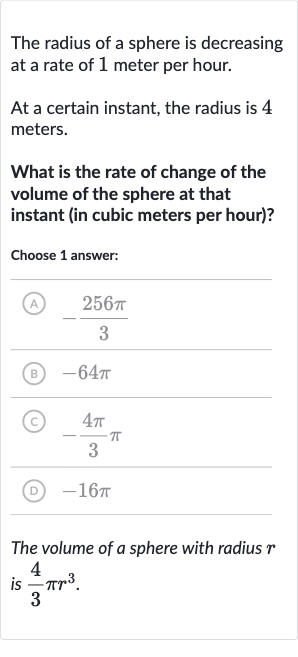AI tutor
Welcome to Bytelearn!
Let’s check out your problem:

The radius of a sphere is decreasing at a rate of meter per hour.At a certain instant, the radius is meters.What is the rate of change of the volume of the sphere at that instant (in cubic meters per hour)?Choose answer:(A) (B) (C) (D) The volume of a sphere with radius is .
Full solution
Q. The radius of a sphere is decreasing at a rate of meter per hour.At a certain instant, the radius is meters.What is the rate of change of the volume of the sphere at that instant (in cubic meters per hour)?Choose answer:(A) (B) (C) (D) The volume of a sphere with radius is .
- Volume Derivative Formula: The formula for the volume of a sphere is . We need to find the derivative of the volume with respect to time, .
- Derivative with Respect to Radius: First, let's find the derivative of with respect to , which is . Using the power rule, .
- Chain Rule Application: Now, we use the chain rule to find . Since (the radius is decreasing), .
- Substitution and Calculation: Substitute and into the equation to get .
- Radius Substitution: Now plug in the value of the radius meters into the equation to calculate the rate of change of volume.
- Final Volume Rate Calculation: The calculation is cubic meters per hour.
More problems from Solve quadratic equations: word problems
QuestionGet tutor help
